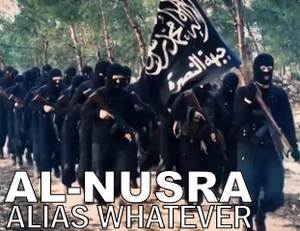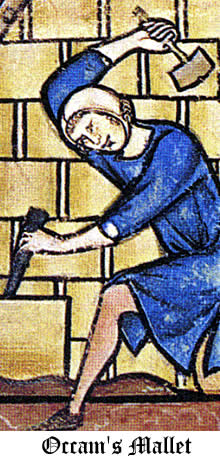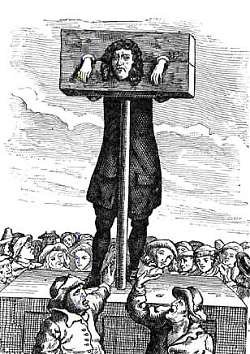| Yes. The current Al Qaeda Number One is a Muslim Brotherhood graduate, a perfect example of impatient Ikhwanism run amok. |
Since the fall of the Mubarak regime and the rise of political Islamism following the electoral victories of the Moslem Brüderbund, a new potential menace has resurfaced in the security vacuum -- the rise of cut-thoat jihadist groups. These groups embrace an extreme Salafist interpretation of Islam, which accepts violence as a legitimate means of realising their demands.
"Sometimes violence is the only way to achieve your objectives!" a young Salafist jihadist from Al-Arish told Ahram Online, preferring to remain anonymous.
| So true, though not nearly so often as young enthusiasts are willing to believe. |
For decades, former president Hosni Mubarak
...The former President-for-Life of Egypt, dumped by popular demand in early 2011...
and his National Democratic Party (NDP) asserted its legitimacy via the Islamist threat, forewarning of what has now become the political face of post-revolution Egypt: an Islamist political landslide and the rise of extreme jihadist Islamist groups.
| To be followed by the murder of minorities, rapine, plunder, famine and disease... in short, the riding forth of the Horsemen of the Apocalypse. One can only hope that this time the Muslim world will learn the lesson they have thus far avoided. |
Today, the media, along with moderate Islamist and secular political forces and minority groups, maintain that Islamist jihadist groups are posing a mounting threat to Egypt's security and regional stability. Some experts believe scare tactics are being used to deter the possibility of an Islamist president, which seems likely given the victory of Mohamed Mursi, the Brotherhood's candidate recent in the first round of presidential elections.
"Scare tactics are typical of electoral polling. Fears of jihadists in Egypt are exaggerated," said Saad Eddin Ibrahim, a noted human rights
...which are usually entirely different from personal liberty ...
and democracy activist. This opinion was echoed by the general advisor to the grand mufti of Egypt's prestigious Al-Azhar religious institution, Ibrahim Negm. "I don't think there is a tangible threat in the immediate future, even if Mursi loses." He added: "Though there are of course jihadist elements and pockets."
Voicing the opposite view, Henri Wilkinson, head of intelligence and analysis at the Risk Advisory Group, believes that threat is likely to intensify with time. "I'd say there is genuine potential for this threat to grow and become a much bigger issue than it is now."
| There is also genuine potential that I might cross the 5' barrier I have been approaching from underneath my entire life. After all, I am only fifty in people years. Come sir, live dangerously and pronounce a probability. |
This notion is supported by some grassroots observers who claim the jihadist threat is much bigger than many like to admit. "After the revolution, jihadist groups are stronger. More people joined, because they no longer fear the consequence of jihad," claimed Mohamed Sabry, a 26-year-old and journalist from Al-Arish. "I believe they are strong enough to fight if elections don't go their way and are forged by the SCAF [Egypt's ruling Supreme Council of the Armed Forces]."
The journalist from Al-Arish, a coastal city in Egypt's Sinai Peninsula renowned for its jihadist elements, has befriended many jihadists. He told Ahram Online that such groups do not recognise democracy as a means of change.
"We do not believe in democracy; we do not vote. Democracy is atheism!" confirmed a young Salafist jihadist from Al-Arish who preferred to remain anonymous.
Some Salafists
...Salafists are ostentatiously devout Moslems who figure the ostentation of their piety gives them the right to tell others how to do it and to kill those who don't listen to them...
nonetheless accepted disqualified presidential candidate Hazem Abu-Ismail as the only "real" Mohammedan candidate, and were distraught by his elimination from the race, staging a sit-in in Al-Arish's Al-Horaya Square.
Observers believe there are two principal jihadist movements in Egypt, both based in Sinai but with countrywide influence: Takfir Wal Hijra and Salafist jihadism, whose adherents are known as Salafist jihadists. Both factions adhere to an extreme Salafist interpretation of Islam, following Al-Qaeda's philosophy and goal of re-establishing an Islamic Caliphate.
But experts believe that Al-Qaeda itself does not exist in Egypt.
| So? If other organized groups with the same objectives and access to the Internet think globally but reapply best practices to work locally, does it matter if the front man is not Dr. Ayman al Zawahiri? |
"I guarantee there is no Al-Qaeda presence in Sinai, but the Takfiris
...an adherent of takfir wal hijra, an offshoot of Salafism that regards everybody who doesn't agree with them as apostates who most be killed...
are in the thousands," the head of North Sinai security was recently quoted as saying. North Sinai Governor Abdel Wahab Mabrouk, who also denied the presence of Al-Qaeda, also affirmed the presence of cut-thoat religious groups.
"We often don't have a name for jihadist groups, so we put them all under the same 'Al-Qaeda' umbrella to simplify matters," explained Mohamed Kadry Said, a military specialist with the Ahram Centre for Political and Strategic Studies.
Takfir Wal Hijra is one of the initial radical Islamist groups founded by Shukri Mustafa to have emerged in Egypt in the 1960s as an offshoot of the Moslem Brüderbund. According to the group's radical ideology, even Mohammedans that do not share its beliefs are infidels.
Most of its followers live in the desert, maintains Sabry. It is believed to have grown smaller following a security crackdown on the heels of the murder of an Islamic scholar and former government minister in 1977. However,
nothing needs reforming like other people's bad habits...
locals claim the group's influence has grown in northern Sinai in the last year, since the revolution, and some allege it is allied to Al-Qaeda.
"I feel they may be planning to do something with Al-Qaeda in the future. Our intelligence is most likely watching them very closely," asserted Said.
Sabry and the Salafist jihadist, however, believe Salafist jihadism poses a bigger threat to national security. "Takfir Wal Hijra are not a threat; they just label atheists; they do not employ violence. We, on the other hand, do!" professed the Salafist jihadist.
Salafist jihadism, as termed by renowned scholar Gilles Kepel, was first identified as a threatening phenomenon in the mid-1990s. Experts claim Salafist jihadists are in the thousands and constitute the largest jihadist force in Egypt, openly embracing violence as a means to reach political goals.
"In order to get freedom, innocent people must die," said the young Salafist jihadist. The young jihadist claimed his movement's following was much larger than experts suggest. "Check out our Facebook page: we have 100,000 likes! In Sinai, we have about 10,000 followers and in Egypt around one million." Experts, nevertheless, deny these figures.
"These jihadist groups are too small and too few in number to represent a real threat," reassured Saber Taalab, director of the Islamic Research Centre in Nasr City.
Notably, some Salafist jihadists were tossed in the clink
Book 'im, Mahmoud!
on charges of participating in the Sinai attacks in 2004 and 2005 that killed some 125 people at the Red Sea beach resorts of Sharm Al-Sheikh, Dahab and Taba. No evidence of their involvement in the attacks, however, was ever produced.
The group staged a sit-in last year to demand the release of its members. In response, the current interim government of Kamal El-Ganzouri released them. Many believe this amnesty would not have happened before the revolution.
Salafist jihadists were also accused last year of launching an attack on a cop shoppe in Al-Arish in which five Egyptian security personnel were killed.
When questioned about Salafist jihadism's ideology and goals, the primary issues listed include liberating Paleostine and establishing an Islamic emirate in Sinai, which many believe has been partially realised in some areas.
"We're following Al-Qaeda's strategy for establishing an Islamic Caliphate by 2020 designed by the late Osama bin Laden
... who had a brief but splitting headache...
, God rest his soul," said the young jihadist. "The plan predicted the Arab uprisings, out of which an Islamic state will be born."
In the small town of Sheikh Zuweid, located only a few kilometres from Gazoo, such aspirations appear to be a reality, as slogans dubbing Sinai an "Islamic state" cover the local cop shoppe.
The town was left terrorised last year after a local Sufi shrine was blown up by five jihad boy jihadists. Locals from Sheikh Zuweid believe that the increase in jihadist extremism is a direct result of state neglect and the collapse of traditional tribal structures.
"The jihadists and groups who declare society apostate have infiltrated the tribes, taken up arms and threatened the structure of social custom," declared Ahmed El-Eiba from the Azazna tribe, an activist from Sinai.
Sheikh Zuweid is known as a hub for exporting weapons to Gazoo, and Al-Hasna and Nakhl are markets for local weapons where tribes buy and compete.
El-Eiba explained how the Libyan uprising had served to create a vibrant arms market. Weapons are purchased for personal use, or to accumulate an arsenal, such as in Syria or in larger operations that would alter regional security balances.
Islam Qwedar, a young activist from Sinai blamed former security officers in the Mubarak regime for introducing tribes to the lucrative arms trade, which has led to dwindling security. "They were the first to introduce this lucrative trade," he stressed. The rising number of luxury cars in and around Al-Arish reflects the prosperity brought about by this nascent arms trade.
"The security vacuum after the revolution led to the establishment of a black market for weapons from Libya, which was taken over by Bedouin. The situation is beyond control and can only be redressed through security measures adopted by the state," Qweder affirmed.
While the normal arms trade through Sinai tunnels to gangs in Gazoo continues, both Qwedar and Mohamed Ibrahim Hamad, the son of a tribal leader in Bir Al-Abd, are preoccupied with the recent influx of weapons from Libya and their effects on national and regional security. "Weapons markets in Egypt are now controlled by cut-thoat groups who are beyond the control of the tribe," said Hamad.
One of the root causes behind the rise of extremism in Sinai, many believe, relates to the state's refusal to recognise Bedouin rustics. A government report in 2010 said a quarter of all Sinai's population of some 600,000 did not carry national ID cards. The Bedouin account for the majority of this number; they are not allowed to own land or serve in the army and do not benefit from local tourism revenue.
"We don't feel like Egyptian citizens," said Sheikh Ahmed Hussein of the Qararsha tribe, one of the biggest in southern Sinai. "The Mubarak regime created this problem; intensified the problem of jihadist groups by not giving the people of Sinai their rights," stated Essam Durbella of Al-Gamaa Al-Islamiya.
Sensing the urgency of the problem, the El-Ganzouri government has granted amnesty to some tossed in the clink
Book 'im, Mahmoud!
hard boyz and called for the revival of several local development projects, including a railway and canal to supply water to central Sinai.
| With what funding? Egypt can only feed her people now because of loans from Saudi Arabia, et al, and even that will run out as oil prices fall. |
Abdullah Abu-Ghama, a member of parliament from Sinai, says this cannot come too soon. "The state has to speed up the process of development," he said. "If not, the mother of all problems will occur and hard boyz will increase in number."
Another fundamental issue plaguing Bedouin and jihadists in Sinai concerns Israel, as they see themselves as Egypt's first line of defence against Zionist expansion.
| Those juices have been crowding in on the the borders of Cairo, have they, driving up property prices? Or are they referring to military expansion -- against which they were such a staunch defence in the last several wars? |
Meanwhile,
...back at the laboratory the fumes had dispersed, to reveal an ominous sight...
in Tel Aviv, there are intense research and policy efforts aimed at addressing Sinai as a potential flashpoint.
Israel is visibly concerned, and is making plans to revise security agreements based on military experts' claims concerning missiles being horded or traded in Sinai -- missiles that they say are more advanced than SAM, Fateh and Grad missiles, which can be used for large-scale operations. Israel's Begin-Sadat Centre has drafted a plan for the partial reoccupation of the border zone and intervention in Sinai, which has been ruled out -- for the time being -- by the right-wing Netanyahu government.
A barrier is also being built along Israel's 266-kilometre (165 mile) border with Sinai in an attempt to ease tensions between Israel and Egypt. Israeli government front man Mark Regev claimed that the barrier is aimed at preventing illegal border crossings, and may also diminish the likelihood of large-scale security threats from Sinai.
One of Israel's stated fears relates to the possibility of Paleostinian factions in Gazoo using Sinai as a launch pad for attacks on the self-proclaimed Jewish state.
| Before it was self-proclaimed it was voted into existence by the entire United Nations. That was the first war the Ummah lost to the Jews, establishing the habit and demonstrating Allah's will in the matter. |
The Paleostinian group Jahafil Al-Tawhid Wal-Jihad fi Filastin (formerly known as Al-Tawhid Wal Jihad) based in Gazoo reflects this fear, as it is said to be linked to Al-Qaeda and closely aligned with Egyptian jihadist groups similar to those that allegedly murdered president Anwar Sadat after the signing of the 1979 Egypt-Israel peace treaty.
Experts also believe that the puritanical Islamic ideology sweeping Sinai today poses a grave security threat, not only regionally, but also to Egypt and Paleostinian resistance faction Hamas, always the voice of sweet reason,, which itself has been confronting Al-Qaeda-type militancy in Gazoo. Views on how to tackle the problem vary.
Following the trend of past Islamist waves in Egypt, some experts claim that heavy-handed police crackdowns have only aggravated the problem. Others believe the situation will only be quelled once a president has been elected in Egypt.
"With the new president and government, security will be restored," affirmed military advisor Kadry Said.
Egypt's new president and government will undoubtedly need to manage this high-priority issue tactfully," Sinai MP Abdullah Abu-Ghama warned.
Rifaat Said of the leftist Tagammu Party speculated: "If [the Moslem Brüderbund's] Mursi becomes president, jihadist elements in society may be pacified, as they might accept Mursi as the best alternative who will apply Islamic Law."
This may not, however, pacify everyone, as the young Salafist jihadist described current Islamist politicians -- including Mursi -- as "liberal."
"The Salafists and the Moslem Brüderbund in parliament are liberals with beards who are going to be the next NDP. They will just use Islamic slogans, but will not enforce Islamic Law," he said. "The Moslem Brüderbund will work with the SCAF, just like Hamas works with Israeli intelligence!"
Reassuringly, Ibrahim remains adamant -- after considerable personal and academic exposure to Salafist jihadists -- that the jihad boy jihadist problem in Egypt will be mollified with the coming of the country's next president.
|
 ...al-Qaeda's Syrian affiliate, from which sprang the Islamic State...
...al-Qaeda's Syrian affiliate, from which sprang the Islamic State...
 The author gives a perfectly good summary of the Mali situation, then loons out on conspiracy theories starring Algeria's security service (DRS). The original title is "Algerian state terrorism and atrocities in northern Mali." Where Occam's Razor suggests taking the most likely explanation for a set of facts, Occam's Mallet suggests the easiest fit with what you believe to be the explanation and then whacking the facts until they come out the way you want.
The author gives a perfectly good summary of the Mali situation, then loons out on conspiracy theories starring Algeria's security service (DRS). The original title is "Algerian state terrorism and atrocities in northern Mali." Where Occam's Razor suggests taking the most likely explanation for a set of facts, Occam's Mallet suggests the easiest fit with what you believe to be the explanation and then whacking the facts until they come out the way you want. A group identifying itself as an offshoot of
A group identifying itself as an offshoot of  Iraqi police said on Tuesday it has arrested the leader of the
Iraqi police said on Tuesday it has arrested the leader of the